No CrossRef data available.
Article contents
The Logic of International Relations and Organization
Published online by Cambridge University Press: 02 September 2013
Abstract

- Type
- Notes and Memoranda
- Information
- Copyright
- Copyright © American Political Science Association 1950
References
1 See further Guggenheim, P. and Potter, Pitman B., The Science of International Relations, Law, and Organization (Geneva, 1940)Google Scholar.
2 Wright, Q. (ed.), The World Community (Chicago, 1948)Google Scholar.
3 For Marxist theory of international relations, see Russell, F. M., Theories of International Relations (New York, 1936), pp. 507–538Google Scholar. The interpretation given in the text derives largely from later elaborations of Communist theory rather than from Marx himself.
4 See Mander, L. A., Foundations of Modern World Society (Stanford, 1947)Google Scholar.
5 We still lack a good summary of the theory of international sanctions or enforcement; see, on one phase, Wehberg, H., Theory and Practice of International Policing (London, 1935)Google Scholar, and, on another, Leonard, L. L., International Regulation of Fisheries (New York, 1944)Google Scholar.
6 For a strong critique of international law in recent times see Dickinson, E. D., “International Law: An Inventory”, California Law Review, Vol. 33, p. 506 (December, 1945)CrossRefGoogle Scholar. On the general problem, see Lauterpacht, H., Function of Law in the International Community (Oxford, 1933)Google Scholar, and documents prepared for the International Law Commission of the United Nations, especially United Nations document A/CN.4/1/Rev.l, Survey of International Law (1949).
7 Wehle, L. B., “The UN By-Passes the International Court”, University of Pennsylvania Law Review, Vol. 98, p. 285 (February, 1950)CrossRefGoogle Scholar.
8 In the matter of war crimes this treatment was, of course, actually very old and very orthodox. International Law Commission, United Nations document A/CN.4/7/Rev. 1, Historical Survey of the Question of International Criminal Jurisdiction (1949), and also Hudson, M. O., International Tribunals, Past and Future (Washington, 1944), pp. 180–186, 265–266Google Scholar.
9 The European Commission of the Danube; see Sayre, F. B., Experiments in International Administration (New York, 1919), p. 39 n.Google Scholar



Comments
No Comments have been published for this article.